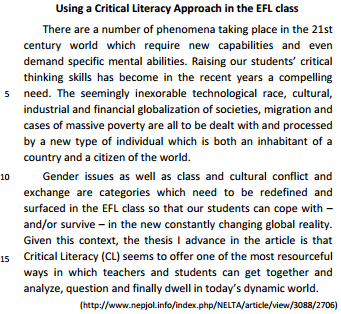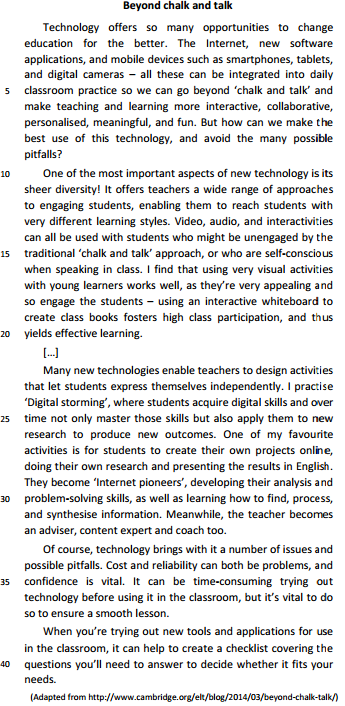Questões de Concurso
Sobre aspectos linguísticos | linguistic aspects em inglês
Foram encontradas 850 questões
The Naval Nuclear Propulsion Program (NNPP) started in 1948. Since that time, the NNPP has provided safe and effective propulsion systems to power submarines, surface combatants, and aircraft carriers. Today, nuclear propulsion enables virtually undetectable US Navy submarines, including the sea-based leg of the strategic triad, and provides essentially inexhaustible propulsion power independent of forward logistical support to both our submarines and aircraft carriers. Over forty percent of the Navy's major combatant ships are nuclear-powered, and because of their demonstrated safety and reliability, these ships have access to seaports throughout the world. The NNPP has consistently sought the best way to affordably meet Navy requirements by evaluating, developing, and delivering a variety of reactor types, fuel systems, and structural materials. The Program has investigated many different fuel systems and reactor design features, and has designed, built, and operated over thirty different reactor designs in over twenty plant types to employ the most promising of these developments in practical applications. Improvements in naval reactor design have allowed increased power and energy to keep pace with the operational requirements of the modern nuclear fleet, while maintaining a conservative design approach that ensures reliability and safety to the crew, the public, and the environment. As just one example of the progress that has been made, the earliest reactor core designs in the NAUTILUS required refueling after about two years while modern reactor cores can last the life of a submarine, or over thirty years without refueling. These improvements have been the result of prudent, conservative engineering, backed by analysis, testing, and prototyping. The NNPP was also a pioneer in developing basic technologies and transferring technology to the civilian nuclear electric power industry. For example, the Program demonstrated the feasibility of commercial nuclear power generation in this country by designing, constructing and operating the Shipping port Atomic Power Station in Pennsylvania and showing the feasibility of a thorium-based breeder reactor.
In: Report on Low Enriched Uranium for Naval Reactor Cores. Page 1. Report to Congress, January 2014. Office of Naval Reactors. US Dept. of Energy. DC 2058 http://fissilematerials.org/library/doe14.pdf
“The NNPP has consistently sought the best way to affordably meet Navy requirements by evaluating, developing, and delivering a variety of reactor types, fuel systems, and structural materials.”
Everyone keeps data. Big organizations spend millions to look after their payroll, customer and transaction data. The penalties for getting it wrong are severe: businesses may collapse, shareholders and customers lose money, and for many organizations (airlines, health boards, energy companies), it is not exaggerating to say that even personal safety may be put at risk. And then there are the lawsuits. The problems in successfully designing, installing, and maintaining such large databases are the subject of numerous books on data management and software engineering. However, many small databases are used within large organizations and also for small businesses, clubs, and private concerns. When these go wrong, it doesn't make the front page of the papers; but the costs, often hidden, can be just as serious.
Where do we find these smaller electronic databases? Sports clubs will have membership information and match results; small businesses might maintain their own customer data. Within large organizations, there will also be a number of small projects to maintain data information that isn't easily or conveniently managed by the large system-wide databases. Researchers may keep their own experiment and survey results; groups will want to manage their own rosters or keep track of equipment; departments may keep their own detailed accounts and submit just a summary to the organization's financial software.
Most of these small databases are set up by end users. These are people whose main job is something other than that of a Computer professional. They will typically be scientists, administrators, technicians, accountants, or teachers, and many will have only modest skills when it comes to spreadsheet or database software.
The resulting databases often do not live up to expectations. Time and energy is expended to set up a few tables in a database product such as Microsoft Access, or in setting up a spreadsheet in a product such as Excel. Even more time is spent collecting and keying in data. But invariably (often within a short time frame) there is a problem producing what seems to be a quite simple report or query. Often this is because the way the tables have been set up makes the required result very awkward, if not impossible, to achieve.
A database that does not fulfill expectations becomes a
costly exercise in more ways than one. We clearly have the
cost of the time and effort expended on setting up an
unsatisfactory application. However, a much more serious
problem is the unability to make the best use of valuable
data. This is especially so for research data. Scientific and
social researchers may spend considerable money and many
years designing experiments, hiring assistants and collecting
and analyzing data, but often very little thought goes into
storing it in an appropriately designed database.
Unfortunately, some quite simple mistakes in design can mean that much of the potential information is lost. The
immediate objective may be satisfied, but unforeseen uses
of the data may be seriously compromised. Next year's grant
opportunities are lost.
Read text III and answer the question:
Text III

Read text II and answer the question:

Read text II and answer the question:

Read text II and answer the question:

Read text I and answer the question.

Read text I and answer the question.

text VI
This is the first chapter of the mythic Star Wars saga.
Set thirty years before the original Star Wars film, Episode I introduces young Anakin Skywalker, a boy with special powers, unaware that the journey he is beginning will transform him into the evil Darth Vader.
Obi-Wan Kenobi, the wise old Jedi from the original series, is a determined young apprentice and Palpatine, well known as the evil Emperor, is an ambitious Senator in the Galactic Republic.
It is a time when the Jedi Knights are the guardians of peace in a turbulent galaxy and a young Queen fights to save her people. In the shadows an evil force is waiting for the right moment to strike.

(Reinildes Dias. Reading Critically in English, 3rd ed. UFMG 2002.)
1.Saga.
2.Unaware.
3.Strike.
4.Evil.
5.Wise.
6.Journey.
( ) Bad.
( ) Trip.
( ) Attack.
( ) Tale.
( ) Oblivious
( ) Prudent.
The correct sequence is
Introducing the perfect chemistry between a green technology and a blue world
There is a formula for a healthy new world. That's why Braskem invested millions in
research to become the first company in the world to use Brazilian sugar cane as a natural
plastic source, collaborating with the reduction of the GHG emissions. Its commitment to
a sustainable development resulted in a benchmark eco-efficient process that estimulates
the markets in which Braskem operates and generates new opportunities.
The world dreamed. Braskem made it happen.

(Newsweek/Issues 2012, Special Edition, cover. Adaptado.)

Considering all the pronouns shown in the comic strip, we could say that:
Self-repairing software tackles malware
University of Utah computer scientists have developed software that not only detects and eradicates never-before-seen viruses and other malware, but also automatically repairs damage caused by them. The software then prevents the invader from ever infecting the computer
again.
A3 is a software suite that works with a virtual machine - a virtual computer that emulates the operations of a computer without dedicated hardware. The A3 software is designed to watch over the virtual machine's operating system and applications, says Eric Eide, University of Utah research assistant professor of computer science leading the university's A3 team with U computer science associate professor John Regehr. A3 is designed to protect servers or similar business-grade computers that run on the Linux operating system. It also has been demonstrated to protect military applications.
The new software called A3, or Advanced Adaptive Applications, was co-developed by Massachusetts-based defense contractor, Raytheon BBN. The four-year project was completed in late September.
There are no plans to adapt A3 for home computers or laptops, but Eide says this could be possible in the future.
"A3 technologies could find their way into consumer products someday, which would help consumer devices protect themselves against fast-spreading malware or internal corruption of software components. But we haven't tried those experiments yet," he says.
Unlike a normal virus scanner on consumer PCs that compares a catalog of known viruses to something that has infected the computer, A3 can detect new, unknown viruses or malware automatically by sensing that something is occurring in the computer's operation that is not correct. It then can stop the virus, approximate a repair for the damaged software code, and then learn to never let that bug enter the machine gain.
While the military has an interest in A3 to enhance cybersecurity for its mission-critical systems, A3 also potentially could be used in the consumer space, such as in web services like Amazon. If a virus or attack stops the service, A3 could repair it in minutes without having to take the servers down.
Source: http://www.sciencedaily.com
"[...]computer scientists have developed software that not only detects and eradicates never-before-seen viruses and other malware, but also automatically repairs damage caused by them".
The words underlined express a meaning of:
Next time you’re swimming in the ocean, consider this: part of the water is older than the sun.
So concludes a team of scientists who ran computer models comparing the ratios of hydrogen isotopes over time. Taking into account new insights that the solar nebula had less ionizing radiation than previously thought, the models show that at least some of the water found in the ocean, as well as in comets, meteorites and on the moon, predate the sun’s birth.
The only other option, the scientists conclude, is that it formed in the cold, intersteller cloud from which the sun itself originated.
The discovery, reported in this week’s Science, stems from the insight of lead author Lauren Ilsedore Cleeves, a doctoral student at the University of Michigan, who realized that planet- forming disks around young stars should be shielded from galactic rays by the strong solar winds, dramatically altering the chemistry occurring inside the disks, said Conel Alexander, with the Carnegie Institution of Washington.
“The findingX makes it quite hard for these regions in the disk to synthesize any new molecules. This was an ‘aha’ moment for us - without any new water creation the only place these ices could have come from was the chemically rich interstellar gas out of which the solar system formed originally,” Cleeves wrote in an email to Discovery News.
“It’s remarkable that these ices survived the entire process of stellar birth,” she added.
The finding has implications for the search for life beyond Earth, as water is believed to be necessary for life.
“If the sun’s formation was typical, interstellar ices - including water - are likely common ingredients present during the formation of all planetary systems, which puts a wonderful outlook on the possibility of other life in the universe,” Cleeves said.
In addition, it’s not just water that likely survived the solar system’s birth.
“The same must be true for the organic matter that we know is present in molecular cloud ices. So I think this strengthens the case that we have interstellar organic matter in meteorites and comets too,” Alexander wrote in an email to Discovery News.
Available in: http://news.discovery.com
I. all the water in the ocean can be considered older than the sun.
II. the water on the planet is ending and, in the future, will be possible to find it on the sun.
III. in the sentence taken from the text: “The only other option, the scientists conclude, is that it formed in the cold, intersteller cloud from which the sun itself originated”, the opposite of the underlined word is “hot”.
The correct assertion(s) is(are)
I would1 look to generate in my friends, and across my generation, a commitment to serving. Whether in schools, hospitals, or on wilderness trails, I’d hope 2 to create in each of us a new, expanded sense of citizenship. We’d spend 3 a year of our lives, before jobs, children, and mortgages complicate our options, building an America where serving is not the obligation of a few – or a possibility only to the privileged.
It would be 4 a real choice for everyone. If I were 22 I’d want to give 5 myself an answer to the question: “Where did you serve?”

Judge the following items according to the text above.

